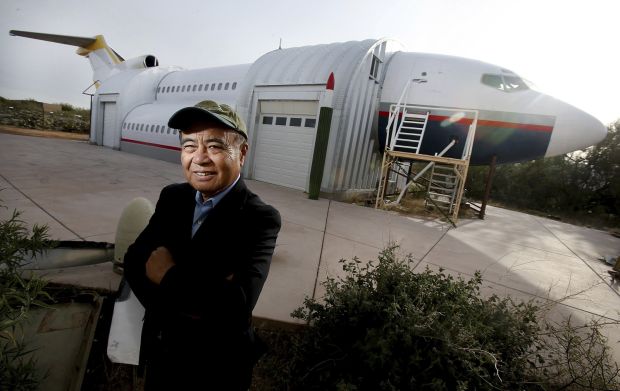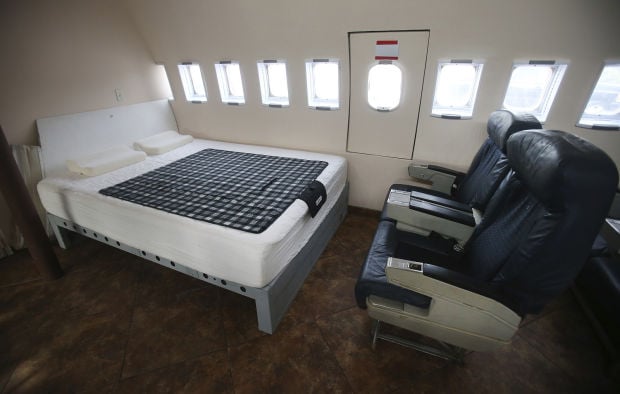The guesthouse in Toshikazu Tsukii’s yard at La Cholla Airpark looks as if it could take off on the adjoining runway.
Tsukii (the last name sounds something like “Ski,” and that’s what everybody calls him) affixed the nose cone of a Boeing 737 and the tail of a 727 to metal garages that flank a two-story guesthouse built from the cabin sections of two 707s.
It is furnished almost totally with surplus airplane parts — the toilet, sink and bathtub being notable exceptions.
A nearby indoor pool is covered with the fuselage of a Boeing 747 jumbo jet.
Tsukii’s wife, Doris, who was a drama student in Wichita, Kan., when she met her future husband, rolled her eyes theatrically when asked her first impression of the four-year backyard project, completed in December.
“There are worse things,” said Doris, who will celebrate 50 years of marriage to Tsukii next month with a cruise through the Panama Canal. “He could be getting into trouble. I’ve had an exciting life with him — a good life — and I’m very proud of him.”
For Tsukii, building the guesthouse accomplished the last of three career goals he established for himself early in life. He wanted to be an aviator, an engineer and an architect. He was the designer and builder for the project.
Tsukii, born in Japan in 1937, was an air cadet at the Japan National Defense Academy before moving to the United States to attend Pasadena City College, Wichita State University and the University of Colorado, majoring in aeronautical engineering, electrical engineering and applied mathematics.
He is a Principal Engineering Fellow at Raytheon Missile Systems, where he has worked for the past 41 years. He holds a number of patents for transmitters and receivers invented for missiles and electronic countermeasures.
He holds licenses as a commercial pilot and flight instructor. He has built two mobile flight simulators using surplus post office jeeps — one with a Cessna nose cone.
He has always had more than one iron in the fire. A 1962 article from the Fort Scott (Kansas) Tribune described how the 24-year-old Wichita State student was putting himself through college working as a TV repairman, electronics technician, sign painter, judo instructor, photographer, folk singer, guitar player and Samurai swordsman.
Tsukii began the airplane project four years ago when he saw the nose cone of the 737 in a scrap metal “boneyard” near Davis-Monthan Air Force Base.
“It was beat up, in bad shape,” he said. He looked beyond appearances. “I got the vision.”
He began planning his guesthouse.
He was fortunate to be living in La Cholla Airpark, where the 91 homes are arranged around a landing strip and many homes have metal airplane hangars on their large lots. “The fact that we’re all on seven acres or more made a difference,” said Gil Alexander, vice president of the airpark homeowners association.
Jumbo-jet architecture is not specifically covered in the association’s covenants, codes and restrictions, Alexander said. “It was unusual, and we had to think about it a bit.”
Tsukii said he had a tougher time with the building inspectors from Oro Valley, whose rules and regulations did not anticipate his vision. He said an inspector who showed up for a roofing-nail inspection asked, “What am I supposed to do with this?”
“That was fun,” Tsukii said.
Oro Valley building official Chuck King said Tsukii’s design probably wouldn’t have passed plan review in other neighborhoods in Oro Valley, where building styles are “nothing too eclectic, fairly consistent.”
The exception seems to be Tsukii’s neighborhood, where the town has dealt with plans such as guesthouses and observation decks atop hangars.
“La Cholla Airpark seems to be a bit of a magnet for uniqueness,” King said.
The town “rotated about three different inspectors through there at various stages. I think everyone wanted a look at it,” said King, who paid a visit himself.
Although the building has “a lot of aspects that don’t fit our standard code requirements,” Tsukii was able to satisfy the spirit, if not the letter, of the law, said King. He had good, detailed plans and engineering designs.
Neighbor Alexander, a retired Raytheon engineer and pilot, said Tsukii’s project is now a great place to hold meetings, such as one held recently by his local chapter of the Experimental Aircraft Association.
“It’s a very interesting place inside and nicely lit.”
Light comes from four rows of airplane windows.
To widen the floor plan, Tsukii cut one 707 fuselage in half, spread it apart and topped the two sections with the second fuselage.
That created lots of space for wide aisles between the pairs of first-class airline seats he installed.
He used surplus wing flaps for counters and dividers. He fashioned glass-topped tables from the engine cowling of a DC-9 and the wheel of a B-57.
At age 76, Tsukii continues to work full time and to fly his two aging Cessnas, including a 1977 Cardinal four-seater that he flew to Kingman recently to supervise the cutting of his 727 tail section into eight pieces for shipment to Oro Valley.
He lost vision in one eye to glaucoma four years ago and had to petition the FAA for his license. “I am one of 3,000 monocular pilots in the United States,” he said.
A lifetime swimmer, he makes regular use of his pool, climbing up a rope ladder to plunge back into the water.
Why did he begin this project so late in life? “It has to be done now,” he said. “Otherwise, it will be too late.”









